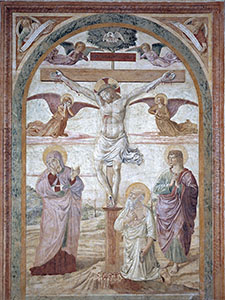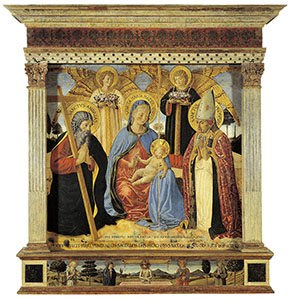
Crucifixion with the Virgin Mary, Saint John the Evangelist, Saint Jerome the Penitent, Weeping Angels and Two Prophets, Church of St. Mary of the Assumption in Barbiano, San Gimignano.

The Madonna of the Humility with Saints Andrew and Prosper, Civic Museum, San Gimignano.
Benozzo first spent time in Valdelsa in 1463, the year in which he received a commission from Fra Domenico Strambi to paint a cycle of frescoes for the main chapel of the Church of St. Augustine in San Gimignano. Strambi, a theologian and scholar who graduated from the Sorbonne, advocated the reform of strict theological rigour within the Augustinian order. He intended this painting to strengthen the spirit of observance through exaltation of the figure of Saint Augustine, a teacher, scholar and advocate of faith who succeeded in reconciling Christianity with the study of Classics.
Benozzo moved to San Gimignano to carry out this considerable work and there he remained until nearly the end of 1467, taking on a series of other engagements including the frescoes commissioned by the people of San Gimignano following the plague that struck the city at around that time. The town’s priors also commissioned the artist to restore the Majesty, a fresco painted in 1317 by Lippo Memmi in the council chamber of the Town Hall.
Benozzo’s work during that period consisted mainly of frescoes (a technique which made him famous as an "excellent master of wall-painting") but also included panel paintings, most of which, fortunately, still survive today.
In Barbariano, a small outlying suburb of San Gimignano, Benozzo painted a fresco depicting the Crucifixion with the Virgin, Saint John the Evangelist, Saint Jerome the Penitent, weeping angels and two prophets in the Church of Santa Maria Assunta which belonged to the old Olivetan Benedictine monastery. With his usual compositional mastery, he succeeded in simulating a sort of opening in the wall, setting the scene in a real landscape with the towers of San Gimignano in the distance. Due to the level of the workmanship of some of the details, critics have theorised that he carried out the work in collaboration with other artists from his studio.
It has been established that, as was customary among artists’ studios, Benozzo used co-workers to help him carry out this sizeable work. These included Giusto d’Andrea, a Florentine painter in his own right who, as he recounted in his Memoirs, had chosen to remain with Benozzo in order to perfect his wall-painting "in art and in virtue"; Giovanni da Mugello, nephew of Fra Angelico, also active in San Gimignano and remembered by Benozzo himself in a letter of thanks to Lorenzo de’ Medici for interceding in his favour during a legal problem, and, finally, in all probability although not proven by written sources, Pier Francesco Fiorentino, a priest and painter who went on to work assiduously in Valdelsa, as demonstrated by many of his signed and dated panel paintings and frescoes. While the involvement of these co-workers may have caused a reduction in quality, particularly in his minor works and in the secondary parts of his major ones, it also allowed Benozzo to produce numerous highly prestigious works in a short space of time, which came to be distributed all over the region.
Serena Nocentini